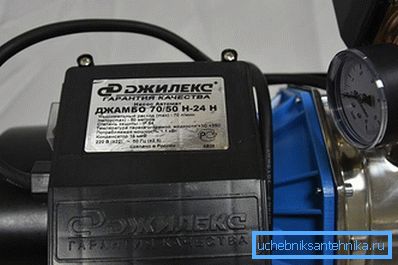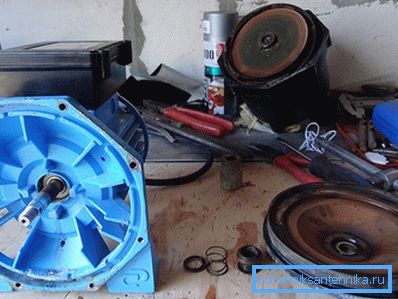Repair of the pumping station itself
The pump station, like any unit, has a warranty period of operation, in case of a device breakdown during this period, the customer service will eliminate it for free. But often, pumping station breakdowns occur after the expiration of the warranty period, and the cost of repairing a breakdown in the service department can cost half the cost, since it is often practiced instead of repair aggregate-nodal replacement, which is expensive. However, repairing a pumping station with your own hands is possible without the help of specialists.
Causes of breakdowns and how to eliminate them

Consider the options for breakdowns and how to eliminate them on the example of a very popular pump station "Jumbo" manufacturer Dzhileks, although these failures can be attributed to most of the existing pumping stations. The peculiarity of this station is the presence of a built-in ejector, which allows raising water from a depth of up to 9 m. The Jumbo pumping station consists of the following nodes:
- centrifugal pump with integrated ejector;
- hydroaccumulator;
- pressure switch with pressure gauge.
| Type of fault | Cause of failure | Remedies |
| 1. The pumping station is working, but does not supply water. | 1.1. There is no tightness at the butt joints of the suction piping or does not hold a check valve, which is installed at the end of this piping. 1.2. The water level has been exceeded (more than 9 m) and the pump simply cannot pump water. 1.3. Most of the working chamber of the pump and impeller due to the high content of abrasive particles in the water, or damaged impeller. 1.4. Low voltage in the network, and the engine can not develop rpm, although it works. | 1.1. Check the tightness of all the connections on the subsea pipeline, repack and tighten the screwed connections if necessary, check the check valve, if it is leaking water, perhaps a grain of sand has hit and the valve does not close tightly. 1.2. It is necessary to reduce the lift height by lowering the pump below, or replace the pump with a submersible one. 1.3. With a large output, the pump will work for itself, in this case the housing with the impeller should be replaced. 1.4. If the voltage under load is below 200 V, then a transformer should be installed. |
| 2. The pump is often turned on, jerky | 2.1. The most common cause of this failure may be the leakage of the membrane of the tank or of the tank itself, or there may be no air in the hydroaccumulator. | 2.1. To ensure the integrity of the rubber membrane, you need to press the spool through which air is pumped into the tank, if water flows from there, it means that the rubber bulb is torn and needs to be replaced. If there is no water, it is necessary to check the air pressure in the accumulator, it should be 0.2 bar less than the lower pump start pressure, approximately 1.5–1.8 atm. If the membrane is intact, but the air pressure is constantly falling, you need to check the valve and the tightness of the tank body, there are cases that cracks appear in the welding joints, you can determine them using soapy water, missed all the joints. If a crack is found, it can be fixed by cold welding or soldered with a soldering iron. |
| 3. The pump is running and does not turn off. | 3.1. The relay is set to very high pressure. 3.2. Pressure switch inlet clogged. 3.3. Suction lift exceeded. | 3.1. Need a little loosen the small spring in the relay. 3.2. It is necessary to disconnect the relay from the pumping station, unscrew the membrane cover and clean the hole. 3.3. See p.1.2 |
| 4. The pump does not create the necessary pressure. | 4.1. See clause 1.1 4.2. The relay is set to very low pressure. | 4.1. See clause 1.1 4.2. Press a little small spring. |
| 5. Pump not working | 5.1. Lack of power at the pump connection terminals. 5.2. Failed pump motor. | 5.1. Check the tester voltage at the contacts of the pump, perhaps the cause of burning contacts in the pressure switch, you need to clean the contacts. 5.2. Often the cause of the failure of the engine is the combustion of the stator winding, due to the ingress of water through a worn gland, or jamming of the shaft bearing, which can be felt by a specific smell. Such a failure is eliminated either by replacing the motor or by winding the winding. |
Replacing the gland bearing

A frequent cause of serious damage to the pumping station becomes improper operation, namely:
- the pump is operated in a room with high humidity, which leads to oxidation of the contacts or seizure of one of the bearings of the pumping station;
- operation of the pump without water for more than 3 minutes leads to failure of the gland, which, in turn, can lead to the closure of the stator windings, due to the ingress of water into the engine.

Guess in advance that you need a replacement gland, can be due to extraneous noise, which publishes the pump, as well as the flow of the pump. To replace the gland, remove the front cover of the pump, the rear protective cover and the engine cooling impeller, fix the shaft with a gas wrench or vice and unscrew the nut that secures the impeller. Remove the impeller, under it on the shaft is the gland. To extract the gland, remove the retaining ring and the first part of the gland, using a screwdriver, “pick out” the second part, replace the gland, smearing the gland and shaft with liquid soap. If the oil seal fails, due to the pump running dry, it is necessary to check whether the water inlets and the impeller cover are deformed, if the deformation is present, then these parts must be replaced.
The jamming of the bearing is fraught with the combustion of the engine itself, since the rotor shaft is blocked.
Malfunction of the bearing can be detected by twisting the fan behind the engine (it will not turn), or the shaft play, and the pump with worn bearings is very noisy during operation. Disassembly of the pump to replace the bearing is based on the principle of changing the gland. It may be difficult to remove the plastic impeller and bearings, for this you need a special puller. After replacing the bearing, you need to run them in, let the engine work by turning it on 2-3 times for several minutes. Before installing the impeller, the shaft must be cleaned of rust and salt deposits.

We also recommend reading the articles:
- Adjust the water pressure switch for the pump.
- Connecting the pumping station to the well.
- How to choose a pumping station.
Video
This video is about how to repair the water station with your own hands:
This video shows the repair of a clogged pressure switch in a pumping station: